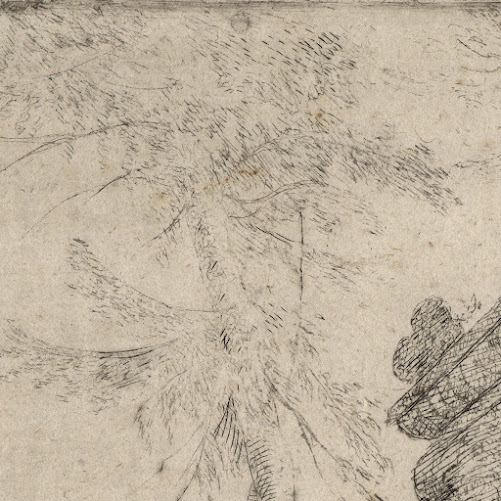Orazio Borgianni (aka Orazio Borgiani) (c1578–1616)
“Joseph Telling His Dreams to His Brothers” (TIB title) (aka “Joseph
racontant à ses frères les songes qu’il a eus”; “Jozef vertelt zijn dromen aan
zijn broers”),1615 (inscribed on plate), plate 25 from the series of 52 etchings
after Raphael (1483–1520), “The Loggia Paintings” (TIB title),
in the Vatican.
Etching on fine laid paper, trimmed around the platemark with a thread margin.
Size: (sheet) 15.1 x 19.5 cm.
Inscribed on plate within the image borderline: (lower-right corner) “1615/ [ligature monogram of artist]”
Numbered by an old hand in brown ink: (lower-right corner) “38”.
Lifetime impression, state i (of ii?). Although I previously understood that the prints in Borgianni’s “Loggia” series were all from a single state, this impression is not numbered in the plate with “25” inscribed at the lower right outside the image borderline, suggesting that this may be an impression from a state before numbering. Note that the Rijksmuseum also has an unnumbered impression whereas the copy held by the British Museum is numbered.
TIB 38 (17).25 (318) (Walter L Strauss [ed.] 1979, “The Illustrated Bartsch”, vol. 38, New York, Abaris Books, p. 384 cat. no. 25 [319]); Bartsch 25 (Adam Bartsch 1803–21, “Le Peintre graveur”, vol. 17, p. 318, cat. no. 25).
The Rijksmuseum offers the following description of this print:
(transl.) “Joseph explains his dream to his brothers. He tells that in his
dream the sheaves of his brothers bowed to his own sheaf and that the sun, moon
and stars also bowed to him”
(http://hdl.handle.net/10934/RM0001.COLLECT.85377).
See also the description of this print offered by the British Museum:
https://www.britishmuseum.org/collection/object/P_1893-1018-19-21.
Condition: a strong impression with brown ink numbering by an old hand at lower right. Beyond remnants of old mounting verso, the sheet is in an excellent condition for its considerable age with no tears, holes, folds, significant stains or foxing.
I am selling this superb etching executed in the last year of the artist’s life and based on the design of the legendary Raphael who had passed away only 95 years before this print was created, for AU$257 (currently US$187.73/EUR159.01/GBP136.35 at the time of this listing) including postage and handling to anywhere in the world, but not (of course) any import duties/taxes imposed by some countries.
If you are interested in purchasing this rare and very interesting Renaissance period print—note the artist’s somewhat crude attempt to create the illusion that the image is edged with a window-box frame by portraying light and shadow cast on it from a light source at upper left—please contact me (oz_jim@printsandprinciples.com) and I will send you a PayPal invoice to make the payment easy.
This print has been sold























































